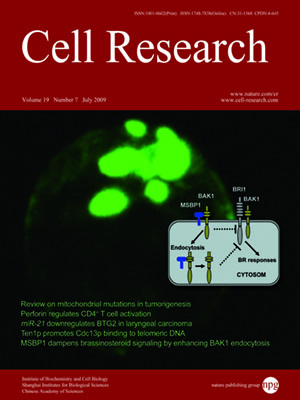
Volume 19, No 7, Jul 2009
ISSN: 1001-0602
EISSN: 1748-7838 2018
impact factor 17.848*
(Clarivate Analytics, 2019)
Volume 19 Issue 7, July 2009: 828-837
ORIGINAL ARTICLES
Regulation of the cell cycle gene, BTG2, by miR-21 in human laryngeal carcinoma
Min Liu, Haidong Wu, Tao Liu, Yixuan Li, Fang Wang, Haiying Wan, Xin Li and Hua Tang
Tianjin Life Science Research Center and Basic Medical School, Tianjin Medical University, Tianjin 300070, China
Correspondence: Hua Tang,(htang2002@yahoo.com )
MicroRNAs are short regulatory RNAs that negatively modulate gene expression at the post-transcriptional level, and are deeply involved in the pathogenesis of several types of cancers. To investigate whether specific miRNAs and their target genes participate in the molecular pathogenesis of laryngeal carcinoma, oligonucleotide microarrays were used to assess the differential expression profiles of microRNAs and mRNAs in laryngeal carcinoma tissues compared with normal tissues. The oncogenic miRNA, microRNA-21 (miR-21), was found to be upregulated in laryngeal carcinoma tissues. Knockdown of miR-21 by specific antisense oligonucleotides inhibited the proliferation potential of HEp-2 cells, whereas overexpression of miR-21 elevated growth activity of the cells, as detected by the colony formation assay. The cell number reduction caused by miR-21 inhibition was due to the loss of control of the G1-S phase transition, instead of a noticeable increase in apoptosis. Subsequently, a new target gene of miR-21, BTG2, was found to be downregulated in laryngeal carcinoma tissues. BTG2 is known to act as a pan-cell cycle regulator and tumor suppressor. These findings indicate that aberrant expression of miR-21 may contribute to the malignant phenotype of laryngeal carcinoma by maintaining a low level of BTG2. The identification of the oncogenic miR-21 and its target gene, BTG2, in laryngeal carcinoma is potentially valuable for cancer diagnosis and therapy.
Cell Research (2009) 19:828-837. doi: 10.1038/cr.2009.72; published online 23 June 2009
FULL TEXT | PDF
Browse 2073


